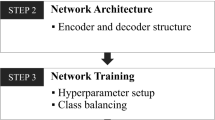Abstract
Deep learning methods have been successfully applied to feature learning in medical applications. In this paper, we proposed a Deep Stacked Auto-Encoder (DSAE) for liver segmentation from CT images. The proposed method composes of three major steps. First, we learned the features with unlabeled data using the auto encoder. Second, these features are fine-tuned to classify the liver among other abdominal organs. Using this technique we got promising classification results on 2D CT data. This classification of the data helps to segment the liver from the abdomen. Finally, segmentation of a liver is refined by post processing method. We focused on the high accuracy of the classification task because of its effect on the accuracy of a better segmentation. We trained the deep stacked auto encoder (DSAE) on 2D CT images and experimentally shows that this method has high classification accuracy and can speed up the clinical task to segment the liver. The mean DICE coefficient is noted to be 90.1% which is better than the state of art methods.
Access this chapter
Tax calculation will be finalised at checkout
Purchases are for personal use only
Similar content being viewed by others
References
Li, D., Liu, L., Kapp, D.S., Xing, L.: Automatic liver contouring for radiotherapy treatment planning. Phys. Med. Biol. 60(19), 7461 (2015)
Seo, K.-S., Kim, H.-B., Park, T., Kim, P.-K., Park, J.-A.: Automatic liver segmentation of contrast enhanced CT images based on histogram processing. In: Wang, L., Chen, K., Ong, Y.S. (eds.) ICNC 2005. LNCS, vol. 3610, pp. 1027–1030. Springer, Heidelberg (2005). https://doi.org/10.1007/11539087_135
Oliveira, D.A., Feitosa, R.Q., Correia, M.M.: Segmentation of liver, its vessels and lesions from CT images for surgical planning. Biomed. Eng. 10(1), 30 (2011)
Peng, J., Hu, P., Lu, F., Peng, Z., Kong, D., Zhang, H.: 3D liver segmentation using multiple region appearances and graph cuts. Med. Phys. 42(12), 6840–6852 (2015)
Rusko, L., Bekes, G., Nemeth, G., Fidrich, M.: Fully automatic liver segmentation for contrast enhanced CT images. In: Proceedings of MICCAI Workshop 3D Segmentation in the Clinic: A Grand Challenge, Brisbane, Australia, vol. 2 (2007)
Song, X., Cheng, M., Wang, B., Huang, S., Huang, X., Yang, J.: Adaptive fast marching method for automatic liver segmentation from CT images. Med. Phys. 40(9), 091917 (2013)
Peng, J., Dong, F., Chen, Y., Kong, D.: A region-appearance-based adaptive variational model for 3D liver segmentation. Med. Phys. 41(4), 43502 (2014)
Krizhevsky, A., Sutskever, I., Hinton, G.E.: Image-net classification with deep convolutional neural networks. In: Advances in Neural Information Processing Systems, pp. 1097–1105. MIT Press, Cambridge (2012)
Long, J., Shelhamer, E., Darrell, T.: Fully convolutional networks for semantic segmentation. In: IEEE Conference on Computer Vision Pattern Recognition, pp. 3431–3440 (2015)
Zhang, W., Deng, R., Li, H., Wang, L., Lin, W., Ji, S., Shen, D.: Deep convolutional neural networks for multi-modality iso-intense infant brain image segmentation. Neuro-Image 108, 214–224 (2015)
Prasoon, A., Petersen, K., Igel, C., Lauze, F., Dam, E., Nielsen, M.: Deep feature learning for knee cartilage segmentation using a triplanar convolutional neural network. In: Mori, K., Sakuma, I., Sato, Y., Barillot, C., Navab, N. (eds.) MICCAI 2013. LNCS, vol. 8150, pp. 246–253. Springer, Heidelberg (2013). https://doi.org/10.1007/978-3-642-40763-5_31
Roth, H.R., Lu, L., Farag, A., Shin, H.-C., Liu, J., Turkbey, E.B., Summers, R.M.: DeepOrgan: multi-level deep convolutional networks for automated pancreas segmentation. In: Navab, N., Hornegger, J., Wells, W.M., Frangi, A.F. (eds.) MICCAI 2015. LNCS, vol. 9349, pp. 556–564. Springer, Cham (2015). https://doi.org/10.1007/978-3-319-24553-9_68
Dolz, J., et al.: Stacking de-noising auto-encoders in a deep network to segment the brainstem on MRI in brain cancer patients: a clinical study. Comput. Med. Imaging Graph. 52, 8–18 (2016)
Vincent, P., Larochelle, H., Lajoie, I., Bengio, Y., Manzagol, P.A.: Stacked de-noising auto encoders: learning useful representations in a deep network with a local de-noising criterion. J. Mach. Learn. Res. 11, 3371–3408 (2010)
Lei, Y., Yuan, W., Wang, H., Wenhu, Y., Bo, W.: A skin segmentation algorithm based on stacked autoencoders. IEEE Trans. Multimedia 19(4), 740–749 (2017)
Zhu, W., Zeng, N., Wang, N.: Sensitivity, specificity, accuracy, associated confidence interval and ROC analysis with practical SAS® implementations. In: NESUG Proceedings: Health Care and Life Sciences, Baltimore, Maryland, vol. 19 (2010)
Acknowledgement
This work was supported by National Hi-Tech Research and Development Program (2015AA043203), and the National Science Foundation Program of China (81430039, 81627803, 61572076).
Author information
Authors and Affiliations
Corresponding author
Editor information
Editors and Affiliations
Rights and permissions
Copyright information
© 2018 Springer Nature Singapore Pte Ltd.
About this paper
Cite this paper
Ahmad, M., Yang, J., Ai, D., Qadri, S.F., Wang, Y. (2018). Deep-Stacked Auto Encoder for Liver Segmentation. In: Wang, Y., et al. Advances in Image and Graphics Technologies. IGTA 2017. Communications in Computer and Information Science, vol 757. Springer, Singapore. https://doi.org/10.1007/978-981-10-7389-2_24
Download citation
DOI: https://doi.org/10.1007/978-981-10-7389-2_24
Published:
Publisher Name: Springer, Singapore
Print ISBN: 978-981-10-7388-5
Online ISBN: 978-981-10-7389-2
eBook Packages: Computer ScienceComputer Science (R0)




